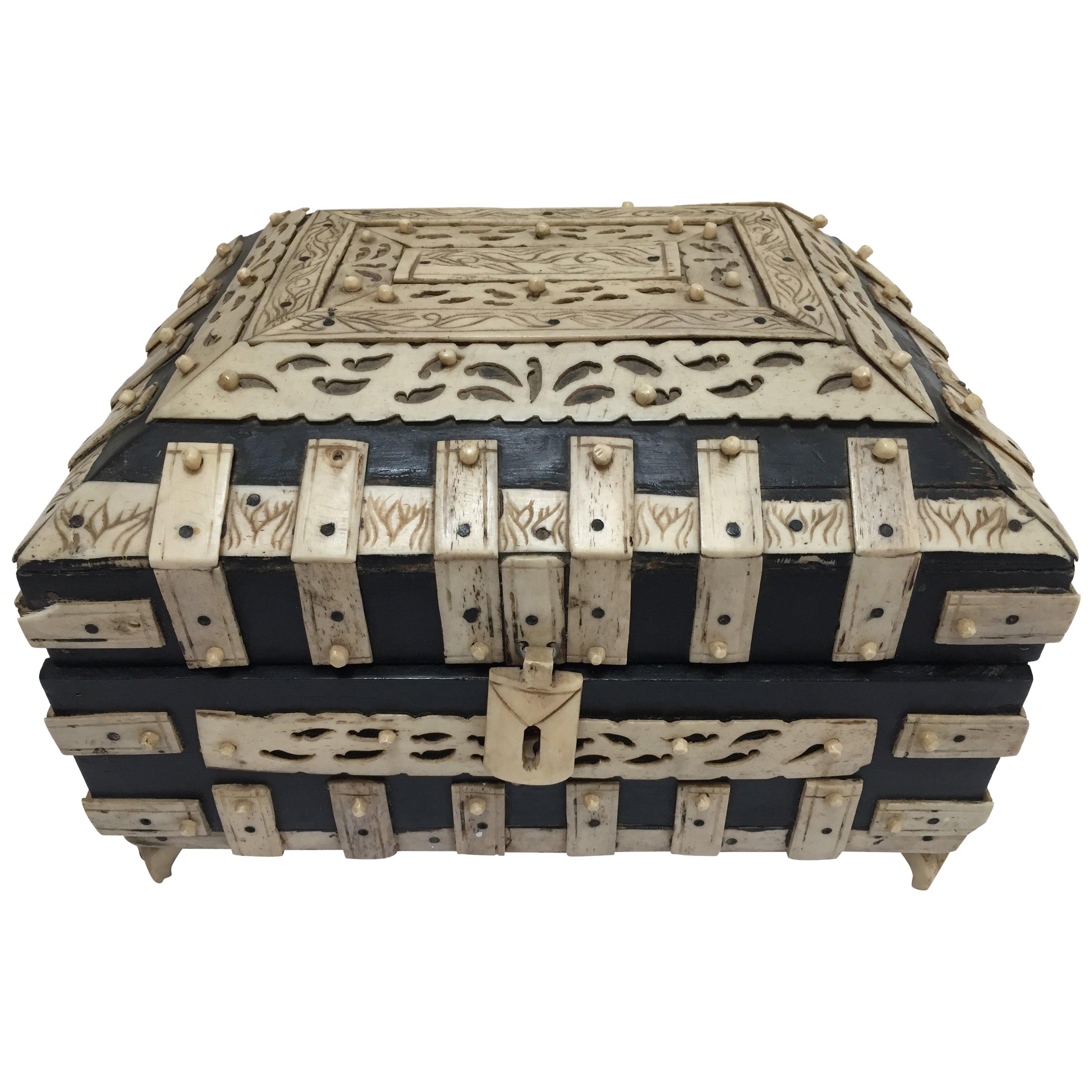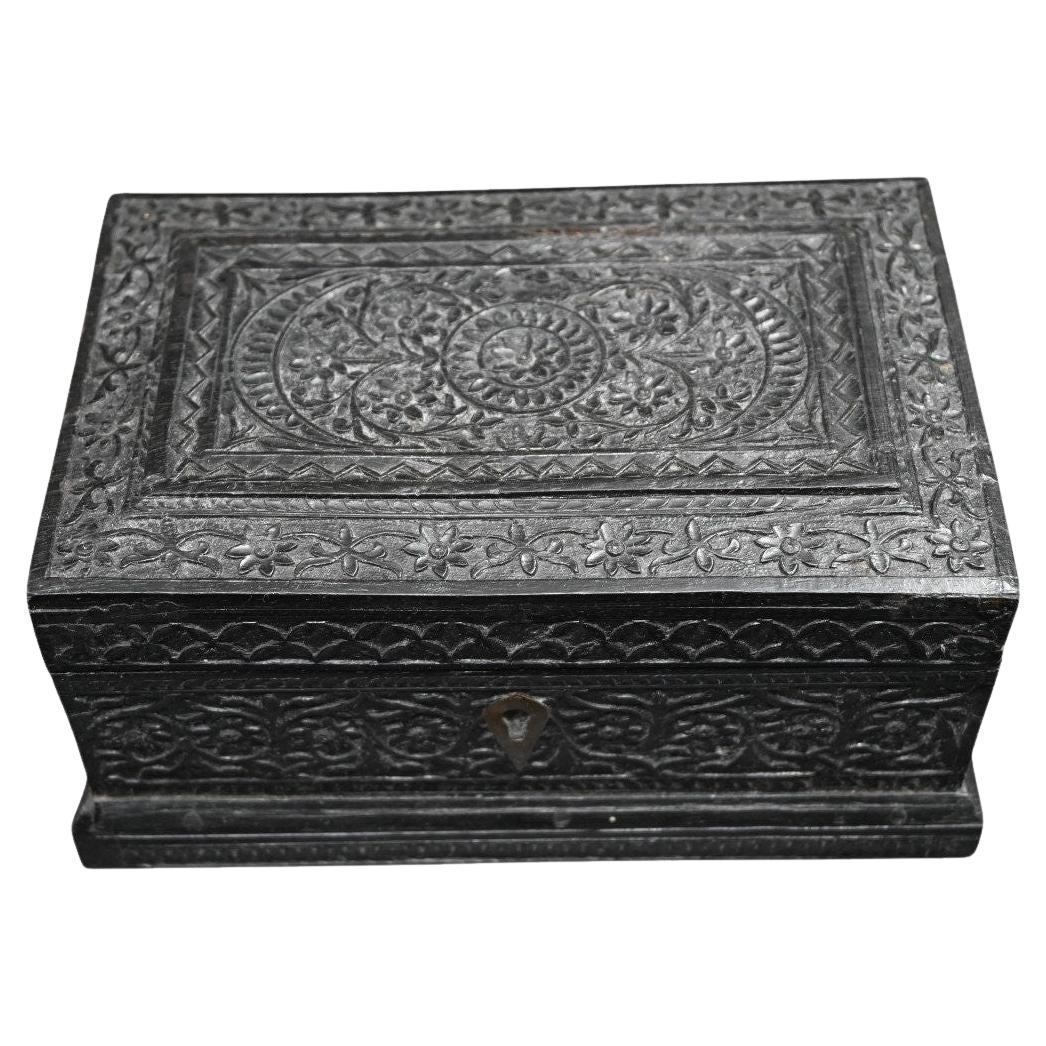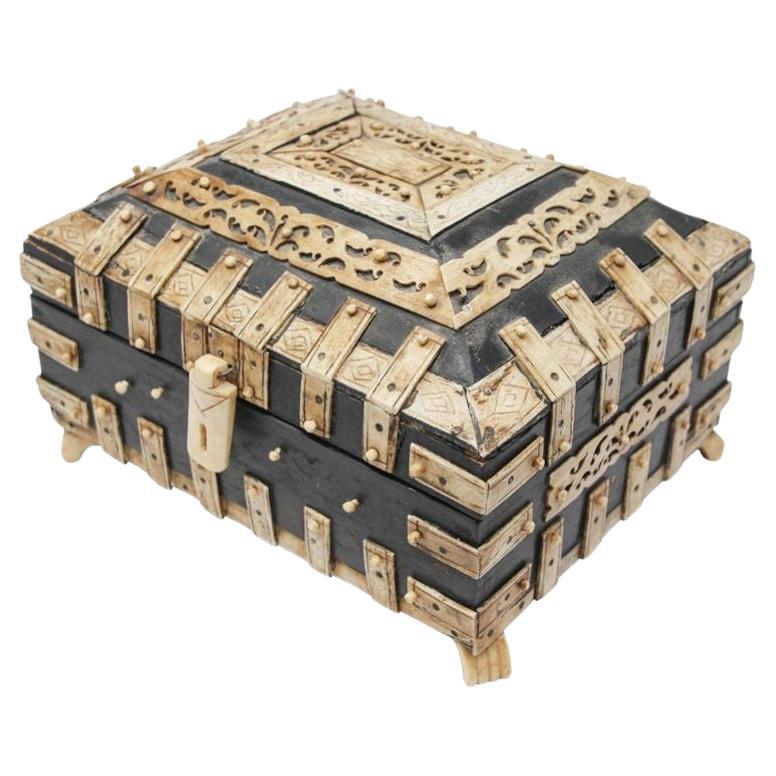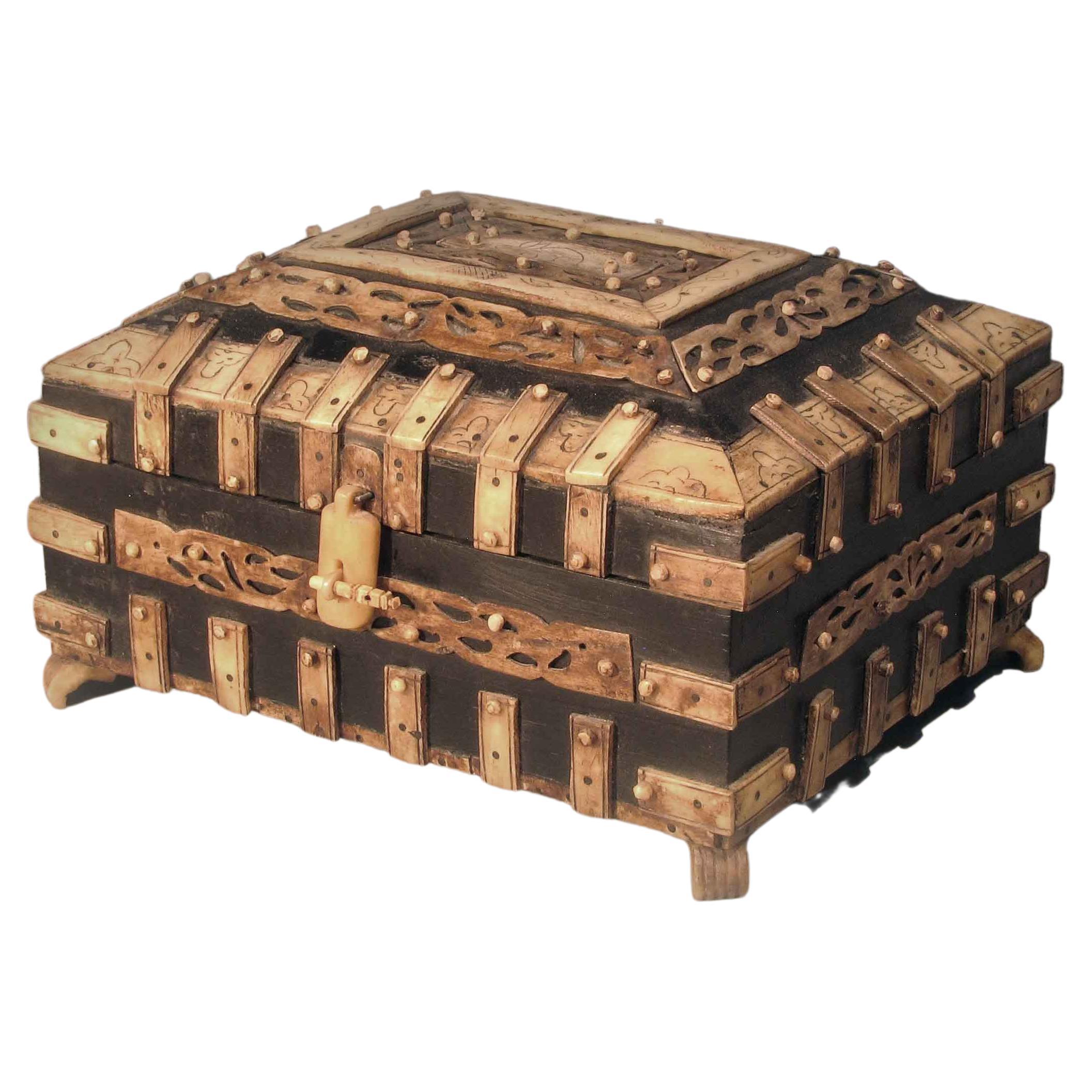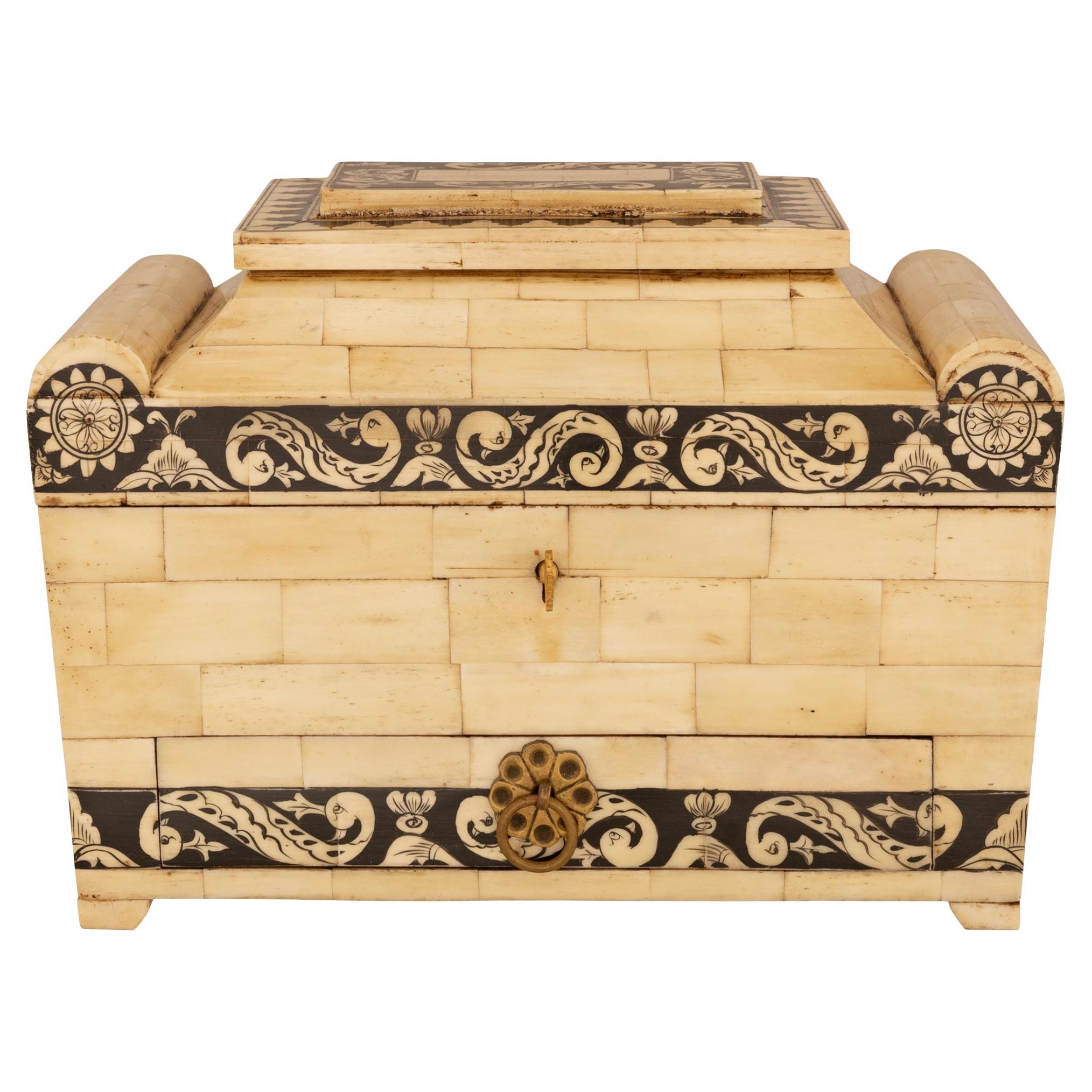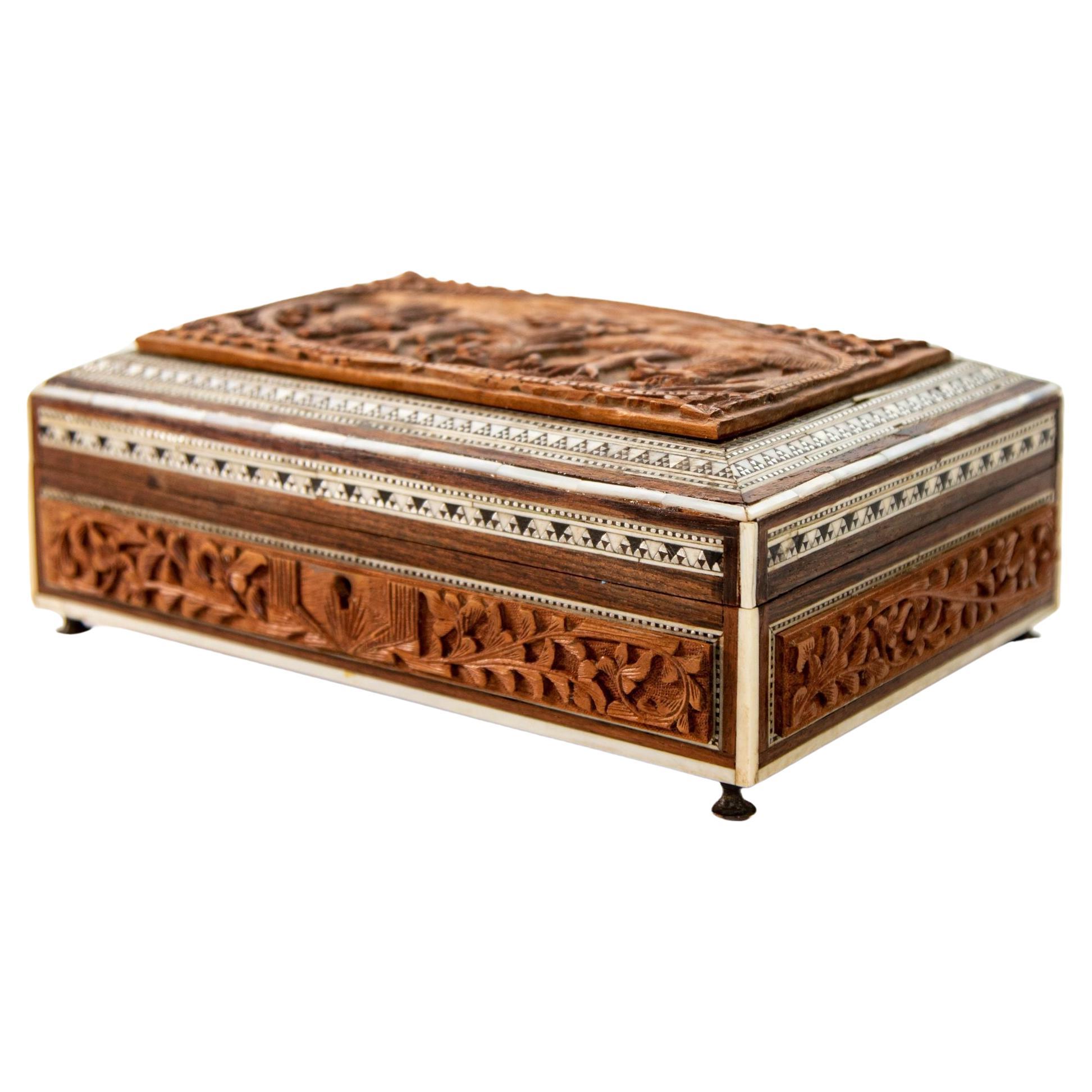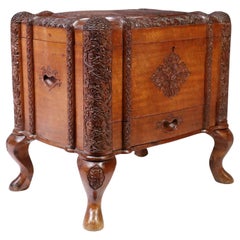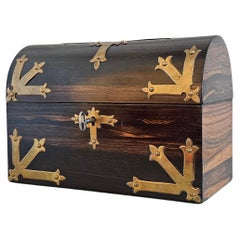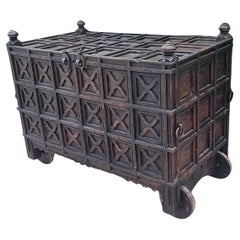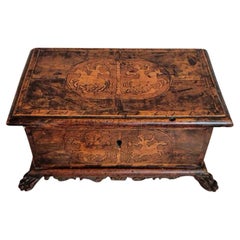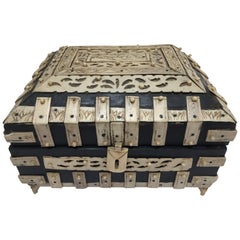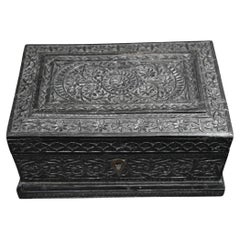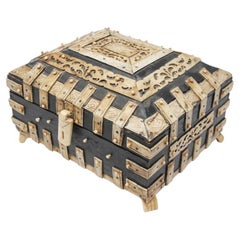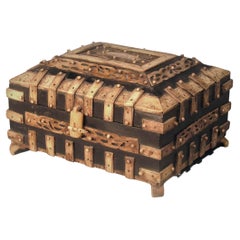Items Similar to Antique Vizagapatam India Table Box Ebonized Wood & Bone Carvings
Want more images or videos?
Request additional images or videos from the seller
1 of 18
Antique Vizagapatam India Table Box Ebonized Wood & Bone Carvings
$850
£645.60
€742.55
CA$1,187.62
A$1,324.33
CHF 690.98
MX$16,249.99
NOK 8,795.04
SEK 8,333.11
DKK 5,541.95
Shipping
Retrieving quote...The 1stDibs Promise:
Authenticity Guarantee,
Money-Back Guarantee,
24-Hour Cancellation
About the Item
Vizagapatam box, India, 19th century.
This highly decorative and unusual Anglo-Indian table box features rustic workmanship that adds to the character and charm of this unique South Asian antique.
Hand-crafted in Vizagapatam, on the south east coast of India, circa 1875, primitive construction, having an ebonized solid wood footed domed casket form, elaborately mounted with hand carved ox bone panels and straps, pierced and etched with geometric designs and stupas, rising on four carved bone paw feet.
PROVENANCE / ACQUISITION:
From a fine Houston Texas private estate
Acquired from the highly reputable auction house, Austin Auction Gallery, est.1983, Austin, Texas. 2024 Mid-Century Modern, Antiques & Asian catalog
DIMENSIONS: (approx)
5.75" High, 9.25" Wide, 7.25" Deep;
HISTORY OF THE ANGLO-INDIAN BOXES:
Beginning in the early part of the 18th century, Indian artisans made what came to be known as Anglo-Indian boxes for the English residents living in India, who eventually brought or sent them back to England. At the beginning of the 19th century, India began exporting these boxes commercially, although not in any significant numbers until the 1850s. People valued them so highly that manufacturers of tins copied the designs on them in the late 19th and early 20th century.
Anglo-Indian boxes fall into four groups: Rosewood or ebony boxes inlaid;
sandalwood boxes veneered; sandalwood boxes covered with Sadeli mosaic; and carved boxes often combined with Sadeli mosaic. The first two categories came from Vizagapatam in East India while the last two came from Bombay in West India.
English traders discovered the rich woods and intricate workmanship of Indian artisans, so colonial government officials began to recognize the work of the Indian artists and craftsmen as a source for satisfying the need for furniture and boxes, which would both serve to enhance English households in India. This gave rise to the cabinetmaking workshops in Vizagapatam between Calcutta and Madras.
Craftsmen made the first boxes to be decorated with Sadeli mosaic of rosewood or ebony, incised to give further definition to the decoration, directly inlaid into the wood. The shape of the early boxes was either sloping at the front with a flatter section at the back, reminiscent of English writing slopes, or rectangular. Artisans inlaid the borders with stylized floral scrolls and the centers with a single floral motif following a circular or oval symmetrical or asymmetrical pattern. The edging was ornamental and protective, both helped protect the end grain against the weather.
Made in Vizagapatam, situated on the south east coast of India, near Madras, these exotic boxes were crafted and retailed in Madras and Calcutta by the English and Dutch East India Companies.
CONDITION REPORT:
Great original antique condition with nicely aged warm rustic patina. Wear consistent with age, use, handling and exposure. Overall a remarkable example
Please note, if the box is empty and the top opened all the way back with no assistance or support, it does not have enough weight to hold the chest down and tips backwards. This can easily be avoided if there is weight in the chest compartment or to simply hold on to the top when opening.
Highly collectible objet d'art, perfect for antique collectors, history enthusiasts, artifact hunters, or anyone looking to elevate their home decor, Vizagapatam box, India, 19th century.
This highly decorative and unusual Anglo-Indian table box features rustic workmanship that adds to the character and charm of this unique South Asian antique.
Hand-crafted in Vizagapatam, on the south east coast of India, circa 1875, primitive construction, having an ebonized solid wood footed domed casket form, elaborately mounted with hand carved ox bone panels and straps, pierced and etched with geometric designs and stupas, rising on four carved bone paw feet.
PROVENANCE / ACQUISITION:
From a fine Houston Texas private estate
Acquired from the highly reputable auction house, Austin Auction Gallery, est.1983, Austin, Texas. 2024 Mid-Century Modern, Antiques & Asian catalog
DIMENSIONS: (approx)
5.75" High, 9.25" Wide, 7.25" Deep;
HISTORY OF THE ANGLO-INDIAN BOXES:
Beginning in the early part of the 18th century, Indian artisans made what came to be known as Anglo-Indian boxes for the English residents living in India, who eventually brought or sent them back to England. At the beginning of the 19th century, India began exporting these boxes commercially, although not in any significant numbers until the 1850s. People valued them so highly that manufacturers of tins copied the designs on them in the late 19th and early 20th century.
Anglo-Indian boxes fall into four groups: Rosewood or ebony boxes inlaid;
sandalwood boxes veneered; sandalwood boxes covered with Sadeli mosaic; and carved boxes often combined with Sadeli mosaic. The first two categories came from Vizagapatam in East India while the last two came from Bombay in West India.
English traders discovered the rich woods and intricate workmanship of Indian artisans, so colonial government officials began to recognize the work of the Indian artists and craftsmen as a source for satisfying the need for furniture and boxes, which would both serve to enhance English households in India. This gave rise to the cabinetmaking workshops in Vizagapatam between Calcutta and Madras.
Craftsmen made the first boxes to be decorated with Sadeli mosaic of rosewood or ebony, incised to give further definition to the decoration, directly inlaid into the wood. The shape of the early boxes was either sloping at the front with a flatter section at the back, reminiscent of English writing slopes, or rectangular. Artisans inlaid the borders with stylized floral scrolls and the centers with a single floral motif following a circular or oval symmetrical or asymmetrical pattern. The edging was ornamental and protective, both helped protect the end grain against the weather.
Made in Vizagapatam, situated on the south east coast of India, near Madras, these exotic boxes were crafted and retailed in Madras and Calcutta by the English and Dutch East India Companies.
CONDITION REPORT:
Great original antique condition with nicely aged warm rustic patina. Wear consistent with age, use, handling and exposure. Overall a remarkable example
Please note, if the box is empty and the top opened all the way back with no assistance or support, it does not have enough weight to hold the chest down and tips backwards. This can easily be avoided if there is weight in the chest compartment or to simply hold on to the top when opening.
Highly collectible objet d'art, perfect for antique collectors, history enthusiasts, artifact hunters, or anyone looking to elevate their home decor, jewelry casket, desk organizer, or simply add a touch of rich cultural interest, sophistication and unique historical intrigue!
- Dimensions:Height: 5.75 in (14.61 cm)Width: 9.25 in (23.5 cm)Depth: 7.25 in (18.42 cm)
- Style:Anglo Raj (Of the Period)
- Materials and Techniques:
- Place of Origin:
- Period:
- Date of Manufacture:circa 1875
- Condition:Wear consistent with age and use. Great original antique condition with nicely aged warm rustic patina. Wear consistent with age, use, handling and exposure. Overall a remarkable example.
- Seller Location:Forney, TX
- Reference Number:1stDibs: LU5977242304692
About the Seller
4.8
Platinum Seller
Premium sellers with a 4.7+ rating and 24-hour response times
Established in 2013
1stDibs seller since 2021
290 sales on 1stDibs
Typical response time: <1 hour
- ShippingRetrieving quote...Shipping from: Forney, TX
- Return Policy
Authenticity Guarantee
In the unlikely event there’s an issue with an item’s authenticity, contact us within 1 year for a full refund. DetailsMoney-Back Guarantee
If your item is not as described, is damaged in transit, or does not arrive, contact us within 7 days for a full refund. Details24-Hour Cancellation
You have a 24-hour grace period in which to reconsider your purchase, with no questions asked.Vetted Professional Sellers
Our world-class sellers must adhere to strict standards for service and quality, maintaining the integrity of our listings.Price-Match Guarantee
If you find that a seller listed the same item for a lower price elsewhere, we’ll match it.Trusted Global Delivery
Our best-in-class carrier network provides specialized shipping options worldwide, including custom delivery.More From This Seller
View AllLarge Antique South Asian Colonial Carved Camphor Wood Table Box Jewelry Casket
Located in Forney, TX
A scarce antique circa 1900 South Asian hand carved wooden decorative table box / jewel casket.
Hand-crafted in the early 20th century, likely British Ceylon (present day Sri Lanka)...
Category
Early 20th Century South Asian Jewelry Boxes
Materials
Wood
Fine Antique English Toulmin & Gale Attrib Madagascar Ebony Stationary Box
By Toulmin & Gale
Located in Forney, TX
A stunning very fine quality antique English stationary box in striking exotic hardwood coromandel / madagascar ebony. circa 1880
Exquisitely hand-crafted in England in the 19th cen...
Category
Antique 19th Century English Victorian Decorative Boxes
Materials
Brass
Monumental Antique Indian Dowry Chest
Located in Forney, TX
A magnificent antique metal-bound solid teak wood damchiya marriage dowry chest with hidden compartments and beautifully aged patina!
Hand-crafte...
Category
Antique 19th Century Indian Rustic Blanket Chests
Materials
Iron
17th/18th Century Italian Venetian Marquetry Table Box
Located in Forney, TX
An important early antique Italian Renaissance table box, handcrafted in Northern Italy in the 17th/18th century, cassone chest form, richly inlaid, the top and front panel with fruitwood banding framing...
Category
Antique 18th Century Italian Renaissance Decorative Boxes
Materials
Wood, Fruitwood
Vintage European Leather Flatware Box Display Chest
Located in Forney, TX
A scarce Continental heavily distressed leather flatware storage box chest, 20th century, finely hand-crafted, rectangular solid wood case, domed ...
Category
20th Century European Decorative Boxes
Materials
Leather, Wood
Antique Chinese Export Black Lacquer Tea Caddy
Located in Forney, TX
A stunning antique Qing Dynasty Chinese export twin canister tea caddy / decorative table box. circa 1860
Hand-crafted in China for the European market when rare and exotic oriental...
Category
Antique 19th Century Chinese Qing Tea Caddies
Materials
Pewter
You May Also Like
Anglo-Indian Vizagapatam Bombay Mughal Style Footed Box With Bone Overlay
Located in North Hollywood, CA
Nice and unusual Indian Mughal style large decorative box, filigree and carved horn.
Anglo-Indian footed domed box with exceptional engraved details throughout with filigree and carved veneered bone plaques with arabesque carving.
Vizagapatam, late 19th century.
History of the Anglo-Indian Boxes
Beginning in the early part of the 18th century, Indian artisans made what came to be known as Anglo-Indian boxes for the English residents living in India, who eventually brought or sent them back to England. At the beginning of the 19th century, India began exporting these boxes commercially, although not in any significant numbers until the 1850s. People valued them so highly that manufacturers of tins copied the designs on them in the late 19th and early 20th century.
Anglo-Indian boxes fall into four groups: Rosewood or ebony boxes inlaid;
sandalwood boxes veneered; sandalwood boxes covered with Sadeli mosaic; and carved boxes often combined with Sadeli mosaic/
The first two categories came from Vizagapatam in East India while the last two came from Bombay in West India.
English traders discovered the rich woods and intricate workmanship of Indian artisans, so colonial government officials began to recognize the work of the Indian artists and craftsmen as a source for satisfying the need for furniture and boxes, which would both serve to enhance English households in India. This gave rise to the cabinetmaking workshops in Vizagapatam between Calcutta and Madras.
Craftsmen made the first boxes to be decorated with Sadeli mosaic of rosewood or ebony, incised to give further definition to the decoration, directly inlaid into the wood. The shape of the early boxes was either sloping at the front with a flatter section at the back, reminiscent of English writing slopes, or rectangular. Artisans inlaid the borders with stylized floral scrolls and the centers with a single floral motif following a circular or oval symmetrical or asymmetrical pattern. The edging was ornamental and protective, both helped protect the end grain against the weather.
Made in Vizagapatam, situated on the south east coast of India, near Madras
These exotic boxes...
Category
Antique Late 19th Century Indian Anglo Raj Decorative Boxes
Materials
Wood
Carved ebony Box, Anglo-indian Box From Vizagapatam
Located in Bilzen, BE
An extraordinary Anglo-Indian box from Vizagapatam in fully carved solid ebony, late 19th century.
Filigree ornate and sculpted floral decoration...
Category
Antique Late 19th Century Indian Anglo-Indian Decorative Boxes
Materials
Ebony
Antique 19th c. Decorative Anglo-Indian Overlay Footed Box with Engraved Bone
By Rajhastani
Located in North Hollywood, CA
Nice and unusual Jewelry decorative box with filigree bone overlaid decoration.
Large Anglo-Indian footed domed box with exceptional engraved bone de...
Category
Antique Late 19th Century Indian Anglo Raj Decorative Boxes
Materials
Wood
Very Decorative Vizagapatam Box INDIA 19th Century
Located in Ottawa, Ontario
VERY DECORATIVE VIZAGAPATAM BOX
Vizagapatam, India, 19th Century.
Rustic workmanship will only add to the decorative appeal of this Anglo-Indian footed domed casket in ebonized woo...
Category
Antique 19th Century Indian Anglo-Indian Decorative Boxes
Materials
Bone
Anglo-Indian 19th century black patinated, Bone and Oak box
Located in West Palm Beach, FL
A very wonderful and most attractive Anglo-Indian 19th century black patinated, Bone and Oak box. This unique rectangular box made of veneered blocks of Bone is supported on four squ...
Category
Antique 19th Century North American Decorative Boxes
Materials
Bone
Antique Anglo-Indian Vizagapatam Jewelry Inlaid Sadeli Footed Box
Located in North Hollywood, CA
Antique 19th century Anglo-Indian jewelry, trinket footed box, inlay with ebony, mosaic marquetry Sadeli work and a carved Hindu scene on top.
The box case is made from sandalwood wi...
Category
Early 20th Century Indian Anglo-Indian Decorative Boxes
Materials
Bone, Mother-of-Pearl, Wood
More Ways To Browse
Antiques India
Estate Jewelry Box
Antique Furniture In India
India Carved Furniture
Carved India Wood
Wood Artifacts
Antique Boxes And Collectables
Exotic Wood Objects
Oval Antique Jewelry Box
Colonial India
Pierced Carving
Box Wood Carving
Bone Handles
India Wood Panel
Asian Handled Box
India Raj
Antique Bone Handle
Indian Antique House
